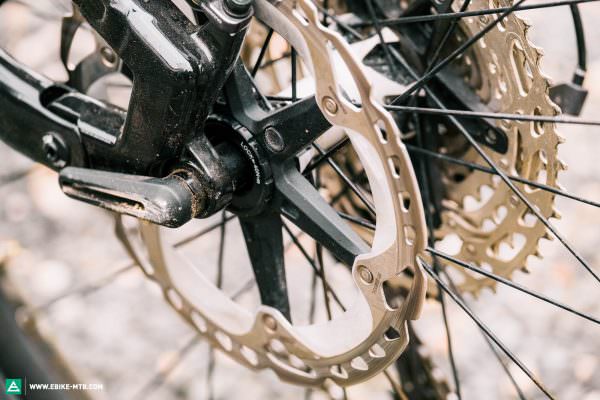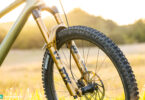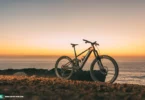The CENTURION No Pogo F3600i is a real eye-catcher! Not just because of key features like the new Shimano EP8 motor with its chunky skid plate and Rockshox coil shock but also because of the elaborately finished gold-texture paint. But can the CENTURION shine as bright as its paint job on the trail?
For an overview of the test fleet head to the group test: The best eMTB of 2021 – 25 models in review

24.90 kg in size L | € 6,599 | Manufacturer’s website
Envious looks guaranteed! With its extravagant finish and captivating silhouette, the € 6,499 CENTURION No Pogo F3600i catches the eye more than any of its competitors. At the heart of the hand-painted alloy frame lies a Shimano EP8 motor, which draws its power from an internal 630 Wh battery. Alternatively, the No Pogo is also available with a Bosch motor. However, the robust and stylish skid plate and in-house chainring conceal the identity of the drive system, giving both models a uniform look. This careful consideration stands in sharp contrast to the (partially) rough welds and messy cable management. CENTURION run the cables and wires through the headset directly into the frame and, unlike FOCUS and CUBE, get rid of any cable ports altogether. However, the cockpit still looks cramped and untidy, not least because of the Lezyne lighting system. Parts such as the charge port and battery lock are highlighted in silver and backed by a suitable pictogram. This is CENTURION’s way of helping eMTB newbies get familiar with their new bike. Cool!
The spec of the CENTURION No Pogo F3600i
Not just the extravagant finish but also the suspension differentiates the CENTURION from the rest of the test field. With 135 mm, it’s the bike with the least rear travel in the entire test field and also the only one that comes equipped with a RockShox Super Deluxe Ultimate coil shock. At the front, a Lyrik Ultimate fork delivers 150 mm travel. Shimano’s four-piston XT brakes are paired with 200 mm rotors front and rear. Shifting is taken care of by a Shimano XT shifter and derailleur combined with a heavy DEORE cassette and matching chain. A DT Swiss H1700 alloy wheelset rolls on 2.6” MAXXIS tires with an ASSEGAI at the front and a DISSECTOR out back – both in the puncture-prone EXO+ casing. The rest of the spec is made up of in-house PROCRAFT components. The highlight is the Drop Pro seatpost, which has 170 mm of travel in size L, up to 200 mm in XL and is easily operated by an ergonomic Shimano remote.

The Lezyne E115 Pro allows you to ride one last sunset lap but is not as powerful as high beam lights like the Supernova fitted to the Cannondale.

The No Pogo is available with either a Bosch or Shimano motor. Thanks to the robust and stylish skid plate, the look is uniform across the model range.

… make sure you choose the right spring rate for the coil shock when ordering your bike. Even with plenty of preload and high-speed compression, the CENTURION blows through its travel on hard impacts.
CENTURION No Pogo F3600i
€ 6,599
Specifications
Motor Shimano EP8 85 Nm
Battery Shimano BT-E8036 630 Wh
Display Shimano SC-EM800
Fork RockShox Lyrik Ultimate RC2 150 mm
Rear Shock RockShox Super Deluxe Coil Ultimate 135 mm
Seatpost PROCRAFT Drop Pro 125–200 mm
Brakes Shimano XT M8120 200/200 mm
Drivetrain Shimano XT/DEORE-Kassette 1x12
Stem PROCRAFT Trail Expert 35 AICR 50 mm
Handlebar PROCRAFT Trail Pro 35 ICR 780 mm
Wheelset DT Swiss H1700 29"
Tires MAXXIS ASSEGAI/DISSECTOR EXO+ 2.6"
Technical Data
Size XS/S M L XL
Weight 24.90 kg
Perm. total weight 150 kg
Max. payload (rider/equipment) 125 kg
Trailer approval yes
Kickstand mount yes
Specific Features
Lezyne lights
Limited edition paintworks

The golden layer is applied by hand, which means that every No Pogo is unique. Luckily, the elegant pattern isn’t ruined by cable ports, because the cables are all routed internally through the headset.

The integration of the Shimano EP8 drive system is seamless. Both the speed sensor with the integrated disc magnet and the cables for the remote and display are well hidden.

Crucial technical parts such as the charge port and battery lock are highlighted in silver and identified by pictograms. This is intended to help newbies get familiar with their new CENTURION.
The CENTURION No Pogo F3600i is available in four sizes and should cater to riders between 1.59 and 2 m tall. At 475 mm in size L, the reach is well-chosen and, in combination with the high front (643 mm stack), ensures plenty of freedom of movement downhill. At 74.7°, the seat angle looks rather slack but the absence of a kink in the seatpost prevents it from slackening further as the dropper extends. On the flats, the rider is positioned centrally above the motor. Unfortunately, this position puts too much pressure on the hands on long rides, thus limiting the long-distance capability and comfort of the bike despite its sensitive suspension.
| Size | XS/S | M | L | XL |
|---|---|---|---|---|
| Seat tube | 390 mm | 420 mm | 460 mm | 500 mm |
| Top tube | 569 mm | 601 mm | 629 mm | 658 mm |
| Head tube | 103 mm | 110 mm | 125 mm | 140 mm |
| Head angle | 66.0° | 66.0° | 66.0° | 66.0° |
| Seat angle | 76.5° | 76.5° | 76.5° | 76.5° |
| Chainstays | 460 mm | 460 mm | 460 mm | 460 mm |
| BB Drop | 35 mm | 35 mm | 35 mm | 35 mm |
| Wheelbase | 1,188 mm | 1,221 mm | 1,252 mm | 1,284 mm |
| Reach | 420 mm | 450 mm | 475 mm | 500 mm |
| Stack | 622 mm | 629 mm | 643 mm | 657 mm |

Jersey Leatt MTB 5.0 | Shorts Leatt Shorts MTB 2.0 | Gloves Leatt DBX 3.0 Lite
Are coil shocks better? The CENTURION No Pogo F3600i on the trail
As with the GIANT, the pedalling position displays its advantages on steep gravel climbs. The front wheel sticks to the ground and allows you to negotiate steep trail sections on loose terrain without having to get out of the saddle. Even on technical singletrails, the CENTURION climbs with confidence and always generates lots of traction despite the shallow profile of the rear tire. The CENTURION steadily winds its way up moderate trails but isn’t particularly exciting in the process. Especially in tight turns, the No Pogo feels sluggish, forcing you to enter corners wide and preventing you from playing with the trail. All in all, the No Pogo delivers a solid climbing performance but fails to put a massive grin on your face.
The range of applications of the CENTURION No Pogo is small: the bike masters demanding climbs with flying colours but lacks long-distance comfort and downhill capabilities.

Tuning tip: make sure to choose the right spring rate for the coil shock at your dealership. Opt for the stiffer setup if you’re in between
While the 24.90 kg No Pogo F3600i delivers a solid climbing performance, it can’t keep up with the competition downhill. The high front, grippy tires and good freedom of movement convey great amounts of confidence and prevent dreaded OTB moments on steep trail sections. The sluggish No Pogo rolls over obstacles with little effort and makes it easy to ride open corners – here the heavy front-end comes in handy too. However, as soon as you get faster the CENTURION reaches its limits. Active riders have to work hard to fire the CENTURION up into the air and will get a nasty surprise when landing: on big hits, the linear coil shock blows through its travel and passes a big part of the impact onto the rider. On top of that, the No Pogo F3600i is pretty loud on rough downhills, where the distinctive clunking noise typical of all EP8 motors is accompanied by the rattling noise of the cables.

Riding Characteristics
7Agility
- sluggish
- playful
Stability
- nervous
- stable
Handling
- demanding
- balanced
Riding fun
- boring
- lively
Motor feeling
- digital
- natural
Motor power
- weak
- strong
Value for money
- poor
- top
Conclusion
With its extravagant paintwork and coil shock, the CENTURION No Pogo F3600i is the true eccentric in our test field. Beginners in particular will benefit from the confidence-inspiring handling and good freedom of movement. On the other hand, experienced and active riders will struggle to find their flow with the sluggish handling of the CENTURION. The No Pogo comes to life on steep climbs, where it feels composed at all times and inspires huge amounts of confidence. Less inspiring is the lack of long-distance comfort, which makes it a rather unattractive option for tourers.
Tops
- confidence inspiring
- plenty of freedom of movement
- feels safe and generates great traction uphill
Flops
- sluggish and overwhelmed downhill
- tiring pedalling position on flats
- untidy cockpit and rattling cables

You can find out more about at centurion.de
The test field
For an overview of the test fleet head to the group test: The best eMTB of 2021 – 25 models in review
All bikes in test: Cannondale Moterra Neo Carbon 1 (Click for review) | Canyon Spectral:ON CF 9 (Click for review) | CENTURION No Pogo F3600i | CUBE Stereo Hybrid 140 HPC SLT Nyon (Click for review) | CUBE Stereo Hybrid 160 C:62 SLT Kiox (Click for review) | Ducati TK-01 RR (Click for review) | FLYER Uproc6 9.50 (Click for review) | FOCUS JAM² 6.9 NINE (Click for review) | GIANT Trance X E+ 1 (Click for review) | Haibike AllMtn 7 (Click for review) | KTM Macina Kapoho Prestige (Click for review) | Lapierre Overvolt GLP 2 Team (Click for review) | MERIDA eONE-SIXTY 10K (Click for review) | Mondraker Crafty Carbon XR (Click for review) | Moustache Samedi 29 Trail 8 (Click for review) | ROTWILD R.X375 ULTRA (Click for review) | Santa Cruz Bullit X01 RSV Air (Click for review) | SCOTT Ransom eRIDE 910 (Click for review) | SIMPLON Rapcon PMAX (Click for review) | Specialized S-Works Turbo Levo (Click for review) | Specialized S-Works Turbo Levo SL (Click for review) | STEVENS E-Inception AM 9.7 GTF (Click for review) | Thömus Lightrider E2 Pro (Click for review) | Trek Rail 9.9 X01 (Click for review) | Whyte E-150 RS 29ER V1 (Click for review)

Relaxed and comfortable riding on surfaced roads, both uphill and downhill.↩
Easy climbs up trails with few obstacles, wide turns and a moderate incline.↩
Active and playful descents on easy trails with few obstacles, wide turns and a moderate slope.↩
Single-track climbs on challenging terrain. Loose ground, steps, roots, tight corners and occasionally extreme inclines.↩
Singletrack descents on challenging terrain. Loose ground, steps, roots, tight corners and small jumps as well as some very steep descents.↩
High speed descents on sometimes very rough trails with large jumps and obstacles that you can’t roll over.↩
The rating used for riding characteristics refers to the bikes in the group test and the current state of development of eMTBs. The best bikes managed to blend supposedly opposite riding characteristics, feeling both lively and stable at the same time. The handling describes the balance of the bike on downhill sections. The information regarding motor-power refers to the ride-feeling in the overall context of the bike and not exclusively to the motor – that’s why the same motor can present different values.↩
Did you enjoy this article? If so, we would be stoked if you decide to support us with a monthly contribution. By becoming a supporter of E-MOUNTAINBIKE, you will help secure a sustainable future for high-quality cycling journalism. Click here to learn more.
Words: Photos: Various









